
ベアリングフォーカスシステム
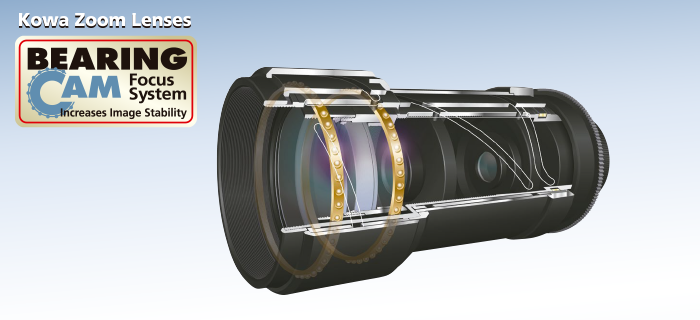
60年以上にわたって培われたコーワの光学機器生産技術は、CCTVレンズの開発・設計思想に遺憾なく発揮・応用されております。プロフェッショナル用レンズに用いられる“3本カム方式”をいち早くCCTVレンズのメカニズムにも搭載することで、光学性能を劣化させる要因だった偏芯を改善し、ガイドピンでの移動メカニズムにおける磨耗も軽減。光学性能はもとより、一層の高精度化と耐久性の向上を実現しました。一方、これにより摩擦部へのグリスの使用を大幅に抑えられるため、温度変化に対する耐候性も大幅に改善。さらに、従来のポール式ではできなかった鏡筒内部への遮光線加工を採用することにより、内部反射も大幅にカットされ、より鮮明な画像での描写が可能になりました。
“3本カム方式” を更に進化・発展させるために採用したのが“ベアリングカムフォーカスシステム”です。長焦点距離の大口径レンズは、レンズ自体の質量が重くなるため可動部の摩擦・摩耗が大きく、また、駆動するためには大きな動力が必要とされてきました。コーワの“ベアリングカムフォーカスシステム”は、それらの問題点を克服。優れた耐久性とスムーズな動きを生み出すことでより一層の長寿命化と省電力化を果たし、確実に機能を発揮し続けるレンズシステムになっております。
超広角から超望遠までのズームレンズ・バリフォーカルレンズ、微細なところまで映し出す超高解像度レンズ、可視光から近赤外光域にまで対応したデイナイト仕様レンズなどを取り揃え、あらゆるシーンに対応。多様化する用途に応じたコーワのCCTVレンズで、一層スピーディーな対応が可能になると確信しております。
ベアリングカムフォーカスシステムは、2メガピクセル超望遠ズームレン ズLMZ20750シリーズ、デイナイト対応2メガピクセルズームレンズLMZ 20550シリーズをはじめ、多くのズームレンズに採用されております。
テクニカルデータ
電動ズームレンズ 自動絞りレンズ用ケーブル接続仕様
※コーワ標準レンズの接続仕様です。 詳しくは取扱説明書をご参照下さい。
■自動絞り付き電動モーターズームレンズ(AMタイプ)
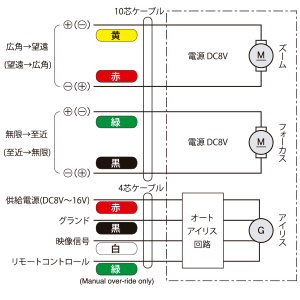
■自動絞り付き電動モーターズームレンズ、プリセット付き(AMPタイプ)

■3モーター電動ズームレンズ(M3タイプ)
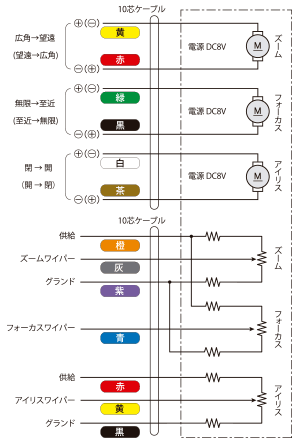
用語説明
1. 画角と視野
A.画角θは次の計算式で得られます。
θ=2tan-1 h/2f
B.視野 Hは次の計算式で得られます。
H=h L/f
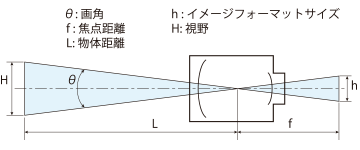
2. F値(口径比)
レンズの明るさに関わり、レンズの口径と焦点距離から算出されます。
口径が大きく、焦点距離が短いほどF値が小さくなり、明るいレンズであることが分かります。
3. イメージフォーマットサイズ
- イメージセンサーサイズ比 1 : 0.69 : 0.5 : 0.38の時
1/2型 フォーマットサイズは1型の50%
1/2型フォーマットサイズは2/3型の73%
1/3型フォーマットサイズは1/2型の75% - 同じレンズを使用した場合、画角はカメラのフォーマットサイズによって変わります。カメラのフォーマットサイズが小さくなるほど、画角は狭くなります。
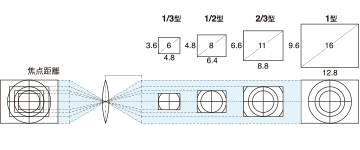
| 1/2型サイズの焦点距離 | 1/3型サイズの焦点距離 |
| f=4mm | f=3mm(2.8mm) |
| f=6mm | f=4.5mm |
| f=12mm | f=9mm(8mm) |
4. フランジバックとバックフォーカス
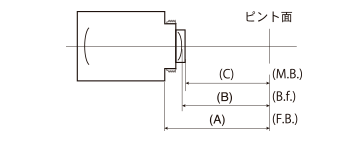
5. CマウントとCSマウント
適合性
| Cマウントカメラ | Cマウントカメラ | |
| CSマウントレンズ | ◯ | ◯ |
| CSマウントレンズ | × | ◯ |
CマウントレンズをCSマウントカメラに使用する場合には、厚さ5mmのC/CSマウント変換アダプターを使用します。
C / CS MOUNT LENS (unit:mm)


